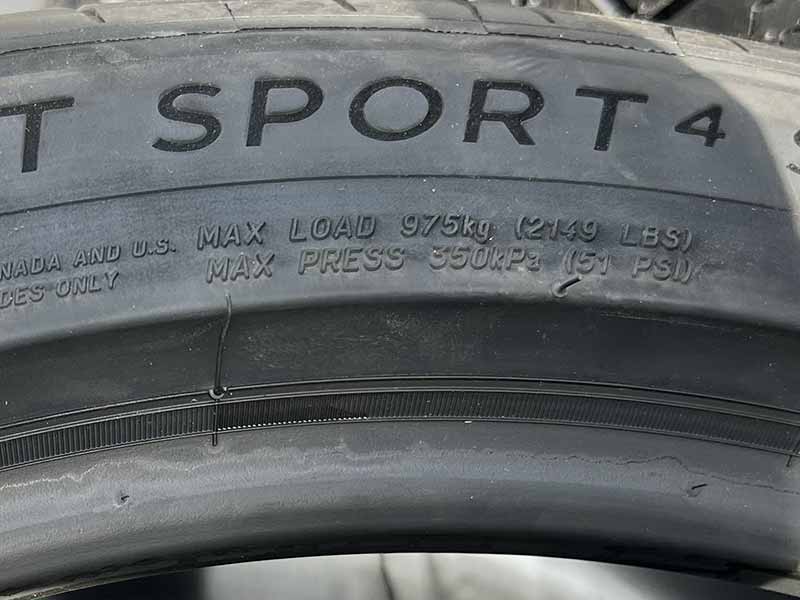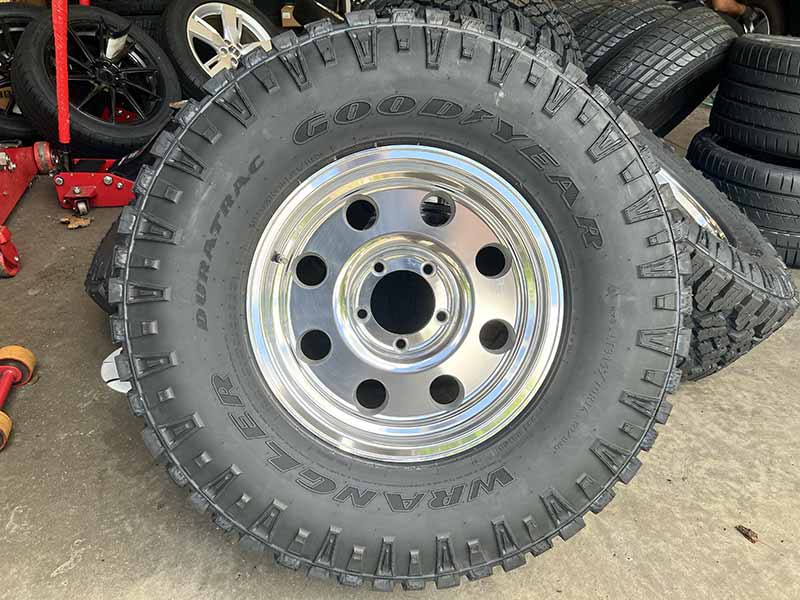Uneven tread wear patterns, like heel and toe wear, show up under a wide variety of tire uses and circumstances.
It can occur on driven tires, non-driven tires, and trailer tires. No matter what your situation is, we’ll help you narrow down the potential causes and identify solutions to help you solve the problem.
Heel Toe Tire Wear
Heel and toe tire wear is uneven wear in a saw tooth pattern when viewed from the side of the tire. This wear pattern is usually isolated to one shoulder and not across the entire width of the tire.
Heel toe wear is usually caused by toe alignment issues but can also be caused by aggressive driving or poor tire maintenance.
Some might become confused and think that heal and toe wear relates to the name of toe alignment of the suspension. While improper toe alignment can cause heel toe wear, it isn’t the reason for the name and is just a coincidence.
Heel and toe wear is named this because it wears the trailing (heel) and leading (toe) edges of the tread blocks.
Let’s take a closer look.
Heel Toe Tire Wear Causes
As with many uneven tire wear patterns, there’s more than one possible cause:
Incorrect Toe Alignment Issues
Alignment issues are a common cause of many types of uneven tire wear patterns. In this case, incorrect toe alignment can cause heel toe wear on the tread blocks along one side of the tire tread or the other.
Toe Out
Inner shoulder wear is a result of toe out. Heel toe wear on the inner shoulder of your tire is a result of excessive toe out and/or moderate toe out combined with another cause.
Toe In
Outer shoulder wear wear is a result of toe in. Heel toe wear on the outer should of your tire is a result of excessive toe in and/or moderate toe in combined with another cause.
Aggressive Driving
In our experience, aggressive driving is a common cause of heel toe tire wear. By “aggressive driving”, we mean braking and accelerating quickly, as well as taking corners high speeds.
These aggressive maneuvers create a lot of stress on your tread and affect how your tire wears. As the tread blocks grip the road surface, either under hard acceleration or heavy braking, they can wear more on one side of the tread block than the other.
Not only will aggressive driving cause uneven wear, it will obviously also significantly reduce the lifespan of your tires.
Not Performing Regular Tire Rotations
Tire rotation is an often neglected tire maintenance job. Depending on the amount of alignment problems and other sources of uneven wear, this can make a significant difference in how long your tires last and their ability to properly grip the pavement.
Failing to perform regular tire rotation causes wear problems to become worse and magnifies the problem. Eventually, the wear will rapidly ruin your tires if left unchecked.
Not only that, but tire rotation is usually one of the requirements for maintaining your tire manufacturer’s warranty. In fact, it’s usually the primary requirement.
If your tires don’t last the full guaranteed mileage and you have met the requirements to maintain the warranty, you can get a prorated discount on your next set of tires for the amount of mileage not met.

Low Tire Pressure / Excessive Loads
In some circumstances, under inflated tires or an overloaded vehicle can cause the tread pattern to flex and deform which will cause the tread blocks to wear more on one edge of the tread block than the other.
This is effectively similar to the effects of aggressive driving, except the force is coming from either improper inflation pressure or weight beyond the recommended limits.
Forcing your tires to operate outside of the pressure and weight range they are designed to handle can do far more damage much more quickly than slight alignment problems or driving style.
How To Fix Heel-Toe Tire Wear
Proper tire maintenance is important to get the most bang for your buck from your tires. It’ll ensure that your tires wear evenly and last as long as possible. This will give you a smooth and quiet ride and ensure you get the maximum traction possible when you need it.
Let’s cover the keys to solving the saw toothed heel and toe wear problem.
Regular Wheel Alignment
Regularly having your wheels aligned is important for maintaining your tires and will help eliminate the chance of heel toe wear from improper toe alignment problems.
Alignment problems are usually caused by potholes, curb strikes, and taking speed bumps at high speed. These hard hits can cause your alignment to drift from the proper settings and even damage suspension components. Do your best to avoid these road hazards or be careful around them.
Don’t Get Fast And Furious
I can’t really help you much with this one, but I do understand. I’m personally prone to driving a little more aggressively than is necessary, and my tires suffer for it when I do. My insurance and driver’s license points also occasionally suffer as well.
Light some incense and do a little calming meditation to relax before getting behind the wheel. Whatever will chill you out so you’re not compelled to explore how many G’s your car can pull when exiting the off ramp.
Rotate Your Tires Every 5,000 Miles
Rotating your tires regularly will help distribute the various types of wear across each tire so they wear more evenly over time. This will improve ride quality, reduce tire noise, and extend tire life.
Every tire position around your car or truck will have their own unique wear patterns. Some will have more shoulder wear, while others may wear more evenly but still have some unusual wear patterns.
Regular tire rotation allows each tire to wear more evenly by basically averaging all of the different wear patterns from each tire across the entire width of the contact patch.
The source of wear problems still need to be resolved to help extend the life of your tires, but rotating your tires will help slow the damage from building up.

Maintain Proper Inflation Pressure And Weight Loads
Always refer to the tire information label in your driver’s door jamb or owner’s manual to insure your inflation pressures and loads are correct.
Neglecting to properly maintain your tires can have more negative consequences than any other issue on this list. Proper inflation pressure is the most important maintenance task to keep within a normal range.
Tires that have to support a greater load than they are rated to carry are not too different than a tire that has an improper inflation pressure.
It’s smart to check your tire pressure monthly and do so properly when the tires are cold and not hot from the stresses of driving or heat from the sun artificially increasing the air pressure.
My recommendation is to purchase a good quality portable air pump with a digital gauge that allows you to easily set your pressures and read them as well. It’ll be handy for regular use and can be extremely helpful in a situation where you really need one.
Dual wheels with mismatched tires or pressures can also end up with sawtoothed tread wear. Be sure to keep tires properly matched and pressures consistent across all tires on the same axle.
Heel Toe Tire Wear Noise
It’s not very practical to try to diagnose heel toe sawtooth treads slapping the pavement through the sound, but more severe cases can cause a whirring sound that can get quite loud in some cases.
If you do detect a sound that is similar to the sound of off-road tire noise you should run your hand over the inner and outer shoulder rib of your tires to see if you feel the sawtooth stepped pattern of diagonal-shaped tread wear.
In fact, larger tread blocks are more prone to this type of uneven wear. If you drive any sort of vehicle that has larger than normal tread blocks, you should pay even more attention to unusually loud tire noise and feel for uneven tread on the shoulders of your tires.
Resources
Below are some links you may find helpful when learning about tires
Final Thoughts
Heel toe tire wear is often caused by toe alignment problems which can occur from curb strikes, pot holes, or even speed bumps. These severe strikes can damage suspension components and tweak alignment settings out of spec.
It would be nice and simple if this were the only cause you needed to focus on. If a proper alignment doesn’t solve it, we should have covered the other potential sources of the problem.
No matter the solution, be sure to stay on top of your tire pressures and rotations. Ensure air pressures are where they need to be. Especially during cold snaps. And keep up with the tire rotation schedule that will ensure your tire warranty remains intact.
Good luck and happy motoring.





